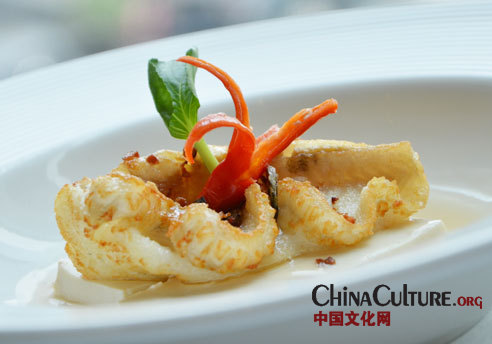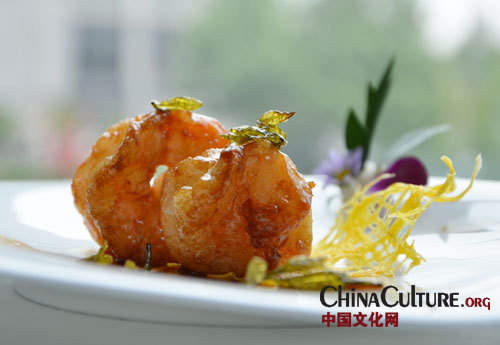
Tea, one of the world’s most ancient and beloved beverages, is an integral part of China’s culture, history, and daily life. But the flavorful and healthy tealeaf isn’t limited to drinking — you can eat it, too.
Using tea in the kitchen is one of the latest trends in the food industry. It is a surprisingly versatile ingredient that can transform spices, marinades, and aromas.
While cooking with tea is becoming more popular, it is by no means a new practice. The custom dates back 1,700 years, and the phrase “eating tea” became popular during the Song dynasty (1127-1279). The historic recipe for Lei Cha, a traditional Hakka tea-based beverage, consists of tea leaves, peanuts, rice, sesame seeds, beans, salt, orange peel, and sometimes herbs.
Each type of tea can serve a distinct function in the kitchen. For example, green tea or partially fermented tea can help develop bland food’s original fresh flavor and add fragrance, while fermented tea, such as oolong, works nicely to eliminate greasiness when preparing meat.
When cooking with tea, it’s important to consider whether to boil, fry, or steam the food to get the best flavor, as well as that food with a strong flavor will inevitably overshadow its delicate fragrance.

In addition to using in spices or marinades, mixing tea with basic ingredients can also turn out a great final product, such as black tea cake, green tea tiramisu, or salty meat mooncake with pu’er tea. Other delicious pairings include oolong and black chocolate or black tea and coffee milk.
Aside from adding flavor to meals, tea can have enormous health benefits. The combination of tea’s health properties — polyphenols (a type of antioxidant) and phytochemicals — can increase endurance, hydrate the body, and protect against illness, including cancer and cardiovascular diseases. When added to food, it can also aid digestion and replace greasy smells with a more pleasant fragrance.
Get cooking with tea with the following dishes:
1. Dragon Well Shrimp (stir-fried shrimp with long jing tea)
 |
|
Dragon Well Shrimp [photo/chinaculture.org by Yang Qi ]
|
Dragon Well tea, also known as Longjing tea, is a famous, high-quality Chinese green tea. It works nicely in cuisine because its leaves are softer than most other green tea leaves and, after being cooked, can be chewed easily.
In this dish, instead of applying the traditional method of frying shrimp with tealeaves simultaneously, you should allow them to become slightly deep-fried by brewing them in hot water. This turns the leaves crispy and sends out a delicious aroma.
The duration and degree of deep-frying is crucial to avoid burning the leaves. In the end, you have a combination of succulent shrimp and crisp, fragrant Dragon Well tea that makes for an impeccable dish.
2. Steamed garouper and tofu with jasmine green tea
 |
|
Steamed garouper and tofu with jasmine green tea [photo/chinaculture.org by Yang Qi ]
|
To start this simple recipe, first brew jasmine green tea in hot water for seven minutes and then strain the leaves. Next, steam the tofu with the brewed tea water so that it absorbs the tea’s fragrance. The jasmine green tea will add a subtle, sweet and slightly scented flavor to the tofu, as well as a green color that makes for a unique dish.
Related Special:
* Experiencing China - Chinese tea culture
* Taipei street food
